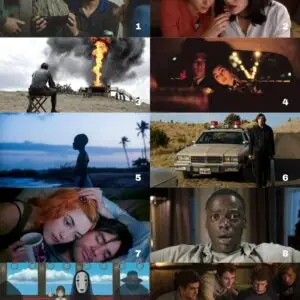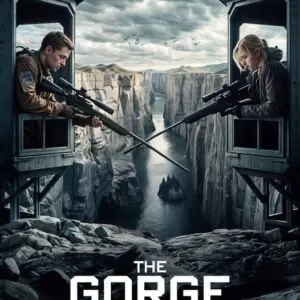Persian Lessons (2020), directed by Vadim Perelman, is a powerful and thought-provoking historical drama that explores the harrowing impact of war on the human spirit. Set against the backdrop of World War II, the film follows a unique and emotional story of survival, hope, and humanity. In particular, it delves into the bond between two men from completely different backgrounds, one a German officer and the other a Jewish prisoner, as they navigate the horrors of a Nazi concentration camp. Through this unlikely relationship, the film also examines the power of language and the personal sacrifices people make in order to hold onto their identity, dignity, and sense of self.
The narrative of Persian Lessons is both gripping and tragic, combining the best elements of historical fiction with emotional depth. The movie not only sheds light on the human cost of war but also presents an uplifting message about the strength of the human will to survive and the possibility of connection in even the darkest of circumstances. Here is a deeper look at the movie’s plot, characters, themes, and the emotional journey that audiences are taken on in Persian Lessons.

The Plot: An Unlikely Bond in the Face of Horror
Persian Lessons begins in 1942, during the height of World War II, when a young Jewish man named Gilles (played by Nahuel Pérez Biscayart) is arrested by the Nazis. He is taken to a concentration camp, where he faces almost certain death. The situation seems dire for Gilles as the Nazis have been systematically exterminating Jewish people in their occupied territories. However, in a twist of fate, Gilles manages to escape execution by lying about his background. When asked his nationality, he boldly claims to be Persian, a nationality that is not commonly associated with Jewish people and therefore raises fewer suspicions in the eyes of the Nazis.
This lie becomes the foundation of the film’s central plot. Gilles, in a desperate attempt to save his life, convinces the Nazi officer in charge of the camp, Klaus Koch (played by Lars Eidinger), that he is from Persia and speaks the Persian language. The officer, fascinated by this seemingly unusual identity, orders Gilles to teach him the Persian language. While Gilles knows no Persian at all, he is forced to create a fictional language, based on the few words he knows from his childhood, in order to survive. He begins to “teach” Klaus Persian, inventing words and phrases, often resorting to fabrication and quick thinking to convince the officer that he is speaking the real language.
Over time, this unusual relationship between Gilles and Klaus grows more complex. While Klaus is clearly interested in learning Persian, there is an underlying tension as he seems increasingly suspicious of Gilles’ true identity. The balance of power between the two becomes an essential dynamic in the film, as Klaus holds the power of life and death over Gilles, while Gilles tries to maintain control over the situation by cleverly lying and evading suspicion. The stakes of this relationship are high, with Gilles’ survival hanging by a thread and Klaus increasingly invested in his “teacher” and the invented language that he believes is real.
As the film unfolds, the viewer is taken on a journey that explores the extremes of human behavior in times of war. Klaus, though an officer of the Nazi regime, is portrayed with nuances that reveal his own vulnerabilities and desires. He becomes attached to the idea of speaking Persian and, in some ways, is symbolically seeking a connection to something beyond the horror of the war, perhaps as an attempt to hold on to some form of humanity amidst the brutality of his surroundings.
Gilles, on the other hand, is a character whose internal struggle becomes more apparent as the film progresses. His decision to fabricate an entire language is not just about survival, but also about holding on to his own sense of identity and humanity in the face of relentless oppression. Through the dynamic between these two characters, the movie examines themes of deception, power, and the lengths people will go to in order to maintain a sense of self in an unforgiving world.

The Characters: A Tale of Two Men in Extremes
The primary relationship in Persian Lessons is between Gilles and Klaus, both of whom are caught in a complex web of survival, deception, and identity. Their evolving relationship forms the emotional backbone of the film.
Gilles is a young Jewish man who, at the start of the movie, is placed in an untenable situation. His quick thinking and willingness to adopt a bold lie are the only reasons he is able to survive his first encounter with the Nazis. Played by Nahuel Pérez Biscayart, Gilles is portrayed as an intelligent, resourceful, and sensitive character. His transformation throughout the film is subtle but significant. At first, he is primarily concerned with survival, willing to lie and deceive as much as necessary. But as he becomes more entrenched in his role as Klaus’s Persian teacher, he begins to grapple with the moral implications of his actions and the emotional toll it takes on him to maintain the lie.
Klaus Koch, the Nazi officer played by Lars Eidinger, is another pivotal character in the film. Klaus is portrayed as an officer who, on the surface, embodies the cruelty and callousness of the Nazi regime. However, as the film progresses, it becomes clear that Klaus is more complex than a mere embodiment of evil. He is a man who, in the midst of his own participation in unspeakable atrocities, is searching for something outside of his horrific reality. His fascination with learning Persian, a language he believes will connect him to a distant, exotic world, symbolizes his desire for something more than the violence that surrounds him. Klaus’s relationship with Gilles becomes an interesting dynamic of power and vulnerability. He holds the life of his “teacher” in his hands but also finds himself emotionally invested in the fictional world that Gilles has created.
Both characters are forced to confront the harshness of their situations, and their evolving relationship becomes a fascinating exploration of human nature in extreme circumstances. In a world filled with hatred, violence, and dehumanization, their unlikely bond—built on language, deception, and necessity—becomes a powerful commentary on the ways in which individuals navigate the complex dynamics of power, survival, and connection.
Themes: Survival, Identity, and Deception
At its heart, Persian Lessons is a film about survival. Gilles’s use of deception—specifically, the creation of a false language—becomes a powerful metaphor for the lengths to which people will go to preserve their lives and identities in the face of annihilation. Survival in the camp is not just about physical endurance; it is about maintaining a sense of who you are in a world that seeks to strip that away.
The film also delves deeply into the theme of identity. Gilles’s entire survival depends on his ability to fabricate an identity that is completely foreign to him. The construction of a false language is symbolic of the broader struggle for personal identity during the Holocaust, where millions of individuals were stripped of their names, cultures, and histories. Through Gilles’s character, the film questions the value and fragility of identity in the face of overwhelming oppression.
Moreover, the deception between Gilles and Klaus is central to the plot. Gilles’s lie—convincing Klaus that he is a Persian speaker—becomes the only thing that allows him to survive. However, this lie is not just a means of survival; it is also a form of resistance. Gilles’s cleverness in creating the fictional language is a small but significant act of defiance against the machinery of war that seeks to dehumanize him. It is a reminder that, even in the most dire situations, the human spirit can find ways to resist and assert itself, even through the smallest acts of subversion.
The Cinematic Craft: Visuals, Direction, and Music
Vadim Perelman’s direction in Persian Lessons is nuanced and thoughtful, allowing the film to delve into its complex themes while maintaining a strong narrative flow. The pacing of the film is steady, with each moment building toward a climax that is both emotionally charged and tragic. Perelman uses the confined setting of the concentration camp to create a sense of claustrophobia, heightening the tension between Gilles and Klaus and making their interactions feel all the more intense and high-stakes.
The cinematography in Persian Lessons complements the bleak and tense atmosphere of the story. The muted color palette reflects the grim reality of the concentration camp while allowing moments of emotional warmth to stand out. In particular, the scenes between Gilles and Klaus are often framed with a focus on their faces, capturing the subtle expressions of doubt, fear, and hope that pass between them.
The music in the film is minimal but effective, often serving to underscore the emotional weight of key scenes without overpowering them. The haunting score complements the sense of foreboding in the story while also highlighting the fragile moments of connection that emerge between the characters.
Conclusion: A Story of Resilience, Humanity, and Hope
Persian Lessons is a haunting and beautifully crafted film that takes an intimate look at the complexities of survival, identity, and deception in the face of the Holocaust. Through the unlikely relationship between Gilles and Klaus, the film presents a thought-provoking exploration of the human spirit’s ability to resist even in the darkest of times. It is a story about the power of language, the importance of holding on to one’s sense of self, and the ways in which people can connect even in the most extreme circumstances.
With its powerful performances, gripping plot, and emotional depth, Persian Lessons is a film that stays with you long after the credits roll. It serves as a reminder of the strength of the human will to survive and the unyielding desire to hold onto one’s humanity, no matter the cost.





